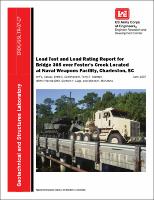Please use this identifier to cite or link to this item:
https://hdl.handle.net/11681/10581| Title: | Load test and load rating report for bridge 305 over Foster's Creek located at Naval Weapons Facility, Charleston, SC |
| Authors: | Bridge Diagnostics, Inc. United States. Army. Installation Management Command Schulz, Jeff L. Commander, Brett C. Stanton, Terry R. Varela-Ortiz, Wilmel Lugo, Carmen Y. McKenna, Mihan H. |
| Keywords: | Concrete bridge Dynamic allowance Finite element model Live load distribution Load test Military vehicles Live loads Design Construction Naval Weapons Facility Charleston South Carolina |
| Publisher: | Geotechnical and Structures Laboratory (U.S.) Engineer Research and Development Center (U.S.) |
| Series/Report no.: | ERDC/GSL TR ; 07-17. |
| Description: | Technical Report Abstract: This study focuses on the load rating analysis of a prestressed concrete channel-beam located at the Naval Weapons Facility in Charleston, SC, subjected to military moving loads through load testing and analytical models. The superstructure of the bridge was instrumented with 56 reusable strain transducers to accurately characterize the structure’s live load response. A load test was initially performed with a 67-kip dump truck across the bridge along three lateral paths. The load test results were used to calibrate a finite element model in order to verify if the structure could safely handle larger loads imposed by the heavy equipment transporter system carrying an M1A1 Abrams tank and the Rough Terrain Container Handler DV43 handler vehicles. Once it was confirmed by the model that these larger vehicles could cross, controlled load tests were performed with both vehicles, and data were recorded during multiple passes of both vehicles. These data were used to verify the predicted responses and to verify that the loads were not inducing damage to the structure. When the testing phase was completed, the data were examined thoroughly, and the model was revised to best represent the actual structural responses. Load ratings were computed for the standard design and rating vehicles along with several heavy military loads. The main conclusions obtained from the load ratings are that all of the design vehicles and military vehicles can cross the bridge within the Operating (maximum) load limits. All of the vehicles, with the exception of the four-wheeled cargo handlers, can cross the bridge within the Inventory (design) load limits. Two of the most important parameters that can be determined when a load testing analysis is performed are the dynamic allowance (impact factor) and the live load distribution. |
| Rights: | Approved for public release; distribution is unlimited. |
| URI: | http://hdl.handle.net/11681/10581 |
| Appears in Collections: | Technical Report |
